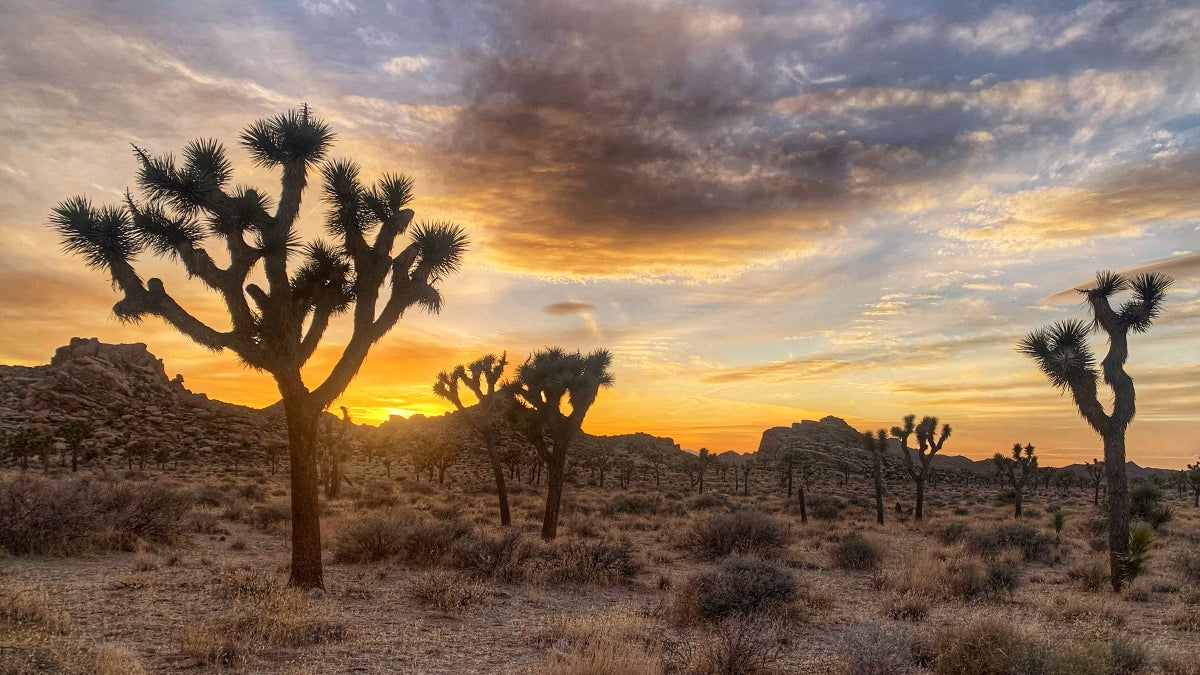No products in the cart.
Outdoor Adventure
The Fight for the Joshua Tree Could Be a Watershed Moment for Species Protection
Species protection doesn’t happen in just swamps or forests—it also happens in courtrooms. In September, a case to list the iconic Joshua tree as threatened on the endangered species list came down on the side of the trees. The lawsuit, which was filed by the nonprofit WildEarth Guardians, had been going back and forth for years. But this time, a California district court judge ruled that when the U.S. Fish and Wildlife Service (USFWS) declined to list the species as threatened in 2019, it was negligent in its analysis of how climate change was decimating the tree’s population. The ruling sent the USFWS back to look at the science. “It affirms our federal government’s responsibility to be forward looking on climate adaptation,” says Jennifer Schwartz, WildEarth Guardians’ lead counsel on the case.
The Joshua tree is a spiky, long-limbed member of the agave family and a cornerstone species in its desert ecosystem. But it is starting to disappear. Making the endangered species list is important for species like the Joshua tree because the designation comes with a federal mandate to protect its habitat and create a recovery plan. It’s one of the most protective environmental laws on the books. Since the passage of the Endangered Species Act in 1973, only 11 listed species have been declared extinct.
But those numbers are sure to start increasing. A week after the Joshua tree ruling, the USFWS proposed removing 22 animals and one plant from the endangered species list because they are extinct. According to a 2019 UN report, a million species are at risk of extinction, and the rates are skyrocketing because of human impacts ranging from land and water use to climate change. The Joshua tree case acknowledges the need to include climate change in the push to protect biodiversity—and to do it now. “This ruling may make the USFWS more comfortable with listing species that currently do not exhibit downward trends in numbers or in habitat but may experience decline decades in the future as a result of climate change,” says Rebecca Hays Barho, a partner at Nossaman LLP who focuses on the Endangered Species Act.
The Joshua tree ruling could open up the funnel for what gets protected.
WildEarth Guardians first filed a petition to list the species as threatened back in 2015 after scientists reported that Joshua tree numbers were declining by 50 percent in the Mojave Desert. The nonprofit argued that the tree’s viability was being decimated by the changing climate. Joshua trees are desert plants, adapted for hot and dry conditions, but they have been pushed too far out of their temperature range by habitat degradation and heat. The trees typically live for hundreds of years, but researchers have found that young trees aren’t sprouting and that increasingly frequent fires, made worse by flammable invasive plants, are torching mature trees. On top of that, climate models under current emissions scenarios show the future getting worse, rendering much of the Joshua tree’s habitat unlivable, including in their namesake national park.
Despite the evidence for protecting the Joshua tree, the case lingered, and in 2019, under the Trump administration, the USFWS said listing wasn’t warranted. WildEarth Guardians pushed back, alleging that the USFWS had blatantly ignored the climate data. “The Endangered Species Act is supposed to be based purely on the best available science,” Schwartz says. “There’s a very strong body of peer-reviewed science, including five key climate models, that have been published over the last two decades that show how Joshua Trees are imperiled.”
So they brought it back to court and argued that the USFWS had failed to uphold its responsibility to science. This time, Judge Otis D. Wright II, from the U.S. District Court for the Central District of California, agreed with them, saying, “The Service’s findings regarding threats posed by climate change and wildfire are unsupported, speculative, or irrational,” and that the Service had to go back and consider the full body of science.
The case is significant because it underlines the importance of modeling and pushes the government to be proactive on species protection. Both of these actions could then become precedent, Hayes Barho says, because federal courts decide cases based on past legal records. And the Joshua tree is not the only tree in peril. Seventy-five percent of redwoods could disappear from California by 2030 as their habitat heats up. On the East Coast, two-thirds of the Atlantic white cedar’s range has been lost to sea level rise and saltwater intrusion.
The Joshua tree ruling, in other words, could open up the funnel for what gets protected. But whether that’s enough to prevent more trees and wildlife from going extinct is hardly guaranteed. We’re already down a path of mass extinction, Schwartz says, and it’s only going to escalate if we don’t use the laws and protections we have in place to help the species that are struggling to survive. “It’s not going to be pretty,” she says. “But avoiding it or kicking it down the line will just make it worse.”
Source link

